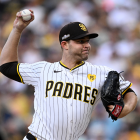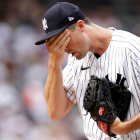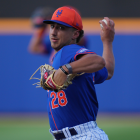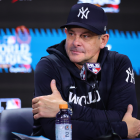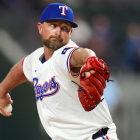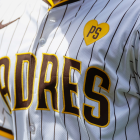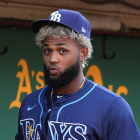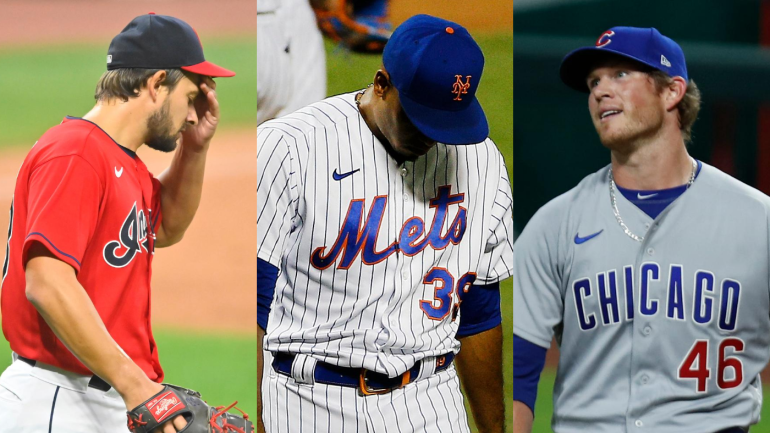
Some ninth innings are diamonds, some ninth innings are rocks. For three former All-Star closers -- Edwin Diaz (Mets), Brad Hand (Cleveland), and Craig Kimbrel (Cubs) -- they've found their allotment of save opportunities in 2020 to be rocks. The trio entered Monday having allowed a combined 11 runs on seven hits (three homers) and nine walks in seven innings.
If the 60-game season is to be played to completion, competing will require teams to hasten decisions that might've normally been permitted more air. That could mean, among other things, changing who has ninth-inning responsibilities at the first sign of continued troubles.
Can either Diaz, Hand, or Kimbrel hang onto their closer's gigs? And, if not, who is in line to replace them? Let's find out.
You can argue that Diaz's tenuous standing has more to do with his struggles in 2019, when he saw his ERA balloon from 1.96 in his final year with the Mariners to 5.59 in his first with the Mets, than with anything he's done so far this season.
Three of Diaz's four appearances have either been successful or understandable, including a blown save versus the Braves on July 25. If that sounds odd -- since when are blown saves against division foes understandable? -- it's because of the context of the blown save. Diaz threw a quality pitch, a 98 mph fastball on the black, and Marcell Ozuna hit it into the bleachers. Juiced-ball home runs count the same as any other, but it was a good pitch in a good spot.
The one true stinker in Diaz's season has been a wild outing against the Red Sox on July 30. He walked two batters and hit another as part of a 35-pitch grindfest that saw him record one out. That was enough for first-year manager Luis Rojas, who subsequently had The Talk with his embattled closer. "We didn't talk about a specific role moving forward," Rojas said, "but we talked about looking forward to getting him back in there as soon as we can."
Diaz needs to improve his command, to be sure, but his stuff looks good. He's throwing a hair harder than he did last season (97.7 mph versus 97.4, per Statcast), and his slider remains a swing-and-miss weapon. One of the surprises of last season was how hard he was hit by the opposition, to the tune of a 90.1 mph exit velocity, or two-plus mph harder than the year prior. In a laughably small sample from this year, he's allowed an exit velocity of 79.3 mph. That number isn't going to stick, at the peak of his powers he was in the 87-to-88-mph range, yet it illustrates that he hasn't been getting tagged the way he did last season, Ozuna homer or not.
Should Rojas and company opt to remove Diaz from the ninth inning -- and it's possible he walks himself out of the role -- they would ostensibly turn over the gig to Seth Lugo. Veterans Dellin Betances, Justin Wilson, and Jeurys Familia also have ninth-inning experience, but it's hard to see any of them leapfrogging Lugo.
Whereas Diaz's short leash makes sense because of last season, Hand's is tougher to figure. This is someone who made the All-Star team in 2019; someone who a well-stocked contender inquired about at the trade deadline; someone who finished with a 145 ERA+ and a 4.67 strikeout-to-walk ratio. What gives? Well, Hand is also someone who missed the end of last season due to a dead arm, and is someone who has shown reduced velocity in 2020.
Indeed, Hand's fastball has clocked in at 90.8 mph so far, or almost two full ticks lower than his 2019 average (92.7), per Statcast. A little less gas might be forgivable on its own, but not when accompanied with a sequence of spotty outings. Hand has yet to produce a clean sheet in his three appearances this season, and last time out, on July 29, he was responsible for a scoreless tie ending as a 4-0 defeat. He allowed a double, issued a walk, and plunked a batter to make it so. (Catcher Beau Taylor added to the misfortune with ill-timed interference.)
There's been no indication that manager Terry Francona is considering a change, or that he's worried about Hand's reduced gas. "That (velocity) isn't the end all and be all," he said after Hand's roughest outing. "You're looking for life, to get some swing-and-miss. There is so much trust in him as a competitor. Sometimes you have to be patient even when it's not easy."
Francona has a point: there are things worth looking at besides the radar gun. Unfortunately, those don't suggest Hand is in tip-top shape, either. Neither his fastball nor his slider are missing the same rate of bats that they did last season, and he's also throwing fewer strikes. It's not worth hitting the panic button yet; the season is so young that two-thirds of the hits Hand has allowed were struck by the same batter (Tim Anderson). It is worth monitoring, however, and it's worth wondering if a softer fastball will impact his signature slider's effectiveness.
Another factor that's fueling the flames of Cleveland's closer controversy is the seeming fait accompli that is James Karinchak filling the role. He wears No. 99, he enters to "Wild Thing," and he talks to himself constantly on the mound. Add in a devastating fastball-breaking ball combination, and Karinchak feels like a future closer. That "future" might well be only a week or two away, depending on if Hand can right the ship and prove that velocity is just a number.
At least with Diaz and Hand, there's some reason for encouragement: Diaz hasn't been hit hard; Hand is still striking out batters, even if he's not missing quite as many bats; and so on. It's significantly harder to find a positive with Kimbrel, who has an average exit velocity-against of 98.5 mph in two appearances, and who has generated one swinging strike on 46 pitches.
The usual caveats about small samples (and especially small samples and relievers) apply here. Still, there's no way to watch Kimbrel's first two outings and walk away thrilled that the likes of Colin Moran, Josh VanMeter, and Freddy Galvis are having comfortable at-bats against the same guy who was, for a good time, probably the most dominant reliever of his generation.
Is it any wonder why rookie manager David Ross, when asked about Kimbrel's hold over the ninth inning, told reporters: "I'm not sure on that. I'll get back to you … I'm in the middle of conversations with Craig. We'll have those with him first."
Presumably part of Ross' conversation with Kimbrel will ask him to pore over his video to see if he can detect any pitch-tipping. He's been reduced to a single-offering pitcher, not in terms of usage, but rather effectiveness. He's thrown 17 breaking balls this season, and not a single one has coerced a swing -- not a swing and a miss, but simply a swing, independent of the result of it. Some of that can be chalked up to poor location, or the counts in which he's throwing the breaker; some of that, though, seems like it stems from a deeper issue, be it him giving away what's coming, or the pitch just not fooling batters out of the hand.
Either way, Kimbrel is going to have to make some serious tweaks in the coming days if he's going to remain the closer. Don't be surprised if the Cubs end up asking Jeremy Jeffress and Rowan Wick to handle ninth-inning duties sooner than later.
![[object Object] Logo](https://sportshub.cbsistatic.com/i/2020/04/22/e9ceb731-8b3f-4c60-98fe-090ab66a2997/screen-shot-2020-04-22-at-11-04-56-am.png)















